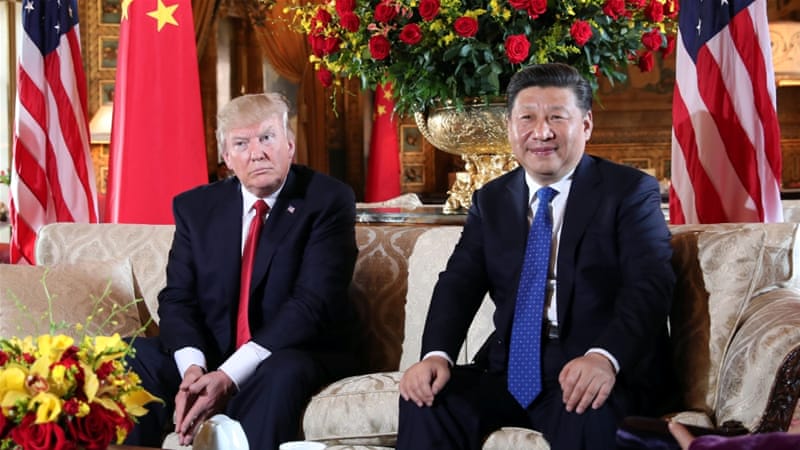
China and the U.S. appear to be entering into a trade war, in which tariffs are imposed on goods imported from the other nation in a tit-for-tat fashion. Recently, U.S. President Trump announced tariffs of $50 billion on imports of high tech products from China, as punishment for China’s alleged forced transfer of technology from U.S. firms doing business in China to their Chinese joint venture counterparts. China had implemented tariffs of $3 billion on imports of pork, wine, and fruit from the U.S. the day before in response to U.S. tariffs on Chinese steel and aluminum imports into the United States.
In response to the $50 billion tariff action, China has threatened tariffs of $50 billion on imports of soybeans, cars, aircraft, and more. However, the announcement comes with a waiting period during which China hopes to negotiate with the United States. American auto companies Ford and General Motors, as well as U.S. farmers, have called for better negotiation between the two countries instead of protectionist measures.
Harmful to both China and U.S.
This will harm both economies, with producers and consumers paying the price for Trump’s poor negotiation tactics. Firms and households in the U.S. will suffer. Pork and wine producers are already set to face new duties and taxes put in place by the Chinese government. Going forward, soybean producers will face a sudden barrier to doing business in their major market if China implements its threatened tariffs. This will hit Trump’s voter base hard if the tariffs are implemented.
Both consumers and producers in China will also face rising costs as a result of the tariffs. Chinese producers of industrial robots, spacecraft, and semiconductors will suddenly have to deal with higher costs and lower profits. Consumers will be confronted with much higher prices of soybeans and automobiles, and will find themselves unable or unwilling to ‘buy American.’ In both countries, consumers are likely to turn to less expensive products, including goods from other nations, while producers may begin the search for less costly markets in other countries.
In the short term, the back-and-forth between the two trading nations has acted as a negative shock to markets. The Dow fell 500 points at the open on April 4 in response to China’s announced retaliation. Soybean prices fell over 5 percent as traders considered the ramifications of Chinese tariffs on the commodity. Dissatisfaction among various sectors has been expressed by several organizations. Farm groups, along with the U.S. Chamber of Commerce and the National Association of Manufacturers, have come out in opposition to Trump’s tariffs.
Room for negotiation?
Both sides have instituted a waiting period before the $50 billion tariffs take effect, with the hope that negotiation may prevent either administration from having to implement them. One has to ask, however, if there really is room for negotiation here? So far, talks between U.S. Treasury Secretary Steven Mnuchin and Chinese Vice Premier Liu He have fallen short of reaching an agreement. For its part, China denies that its firms have forced American companies doing business overseas to hand over their technology secrets. On the other side, some advisors in the Trump administration appear unfazed by the trade war. Commerce Secretary Wilbur Ross stated that China's tariffs "amount to about three-tenths of a percent of our GDP. So, it's hardly a life-threatening activity.”
This high-level view, however, prevents many in the Trump administration from comprehending the harm the tariffs will do on the ground. For instance, I doubt that American soybean farmers would take Ross’ perspective, as the 0.3 percent of GDP he mentions hits them square in the balance sheet. Even though individuals like Treasury Secretary Mnuchin have been in favor of negotiation, the administration as a whole has taken an aggressive stance. The overall perspective on the intellectual property investigation and the resulting tariffs is that the U.S. has been pressing China for years to stop its firms from forcing their American partners to hand over their technology, with no real change. Therefore, according to Trump’s advisors, a hard line must be taken to end this practice.
The announced tariffs represent a hard line, indeed. Few analysts truly expected a full-blown trade war; several months ago, this seemed like only a very remote possibility. Even though the large-scale tariffs have not yet taken effect, their unveiling has created a posture of brinksmanship between the world’s most powerful economies. This is a dangerous game that previous administrations have refrained from playing, not out of weakness, but out of wisdom. One can only hope that the Trump administration will take the high road and negotiate with China before the tariffs come into force. Unfortunately, due to the unpredictable nature of the Trump administration, this cannot be assured.




